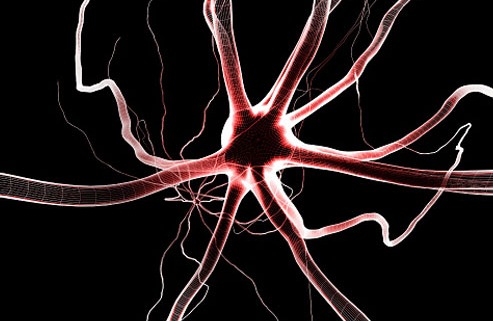


Algemeen wordt aangenomen dat acupunctuur het zenuwsysteem kan stimuleren en de afgifte van neurotransmitters beïnvloeden.
Deze biochemische veranderingen beïnvloeden de homeostatische mechanismen van het lichaam, en verbeteren het lichamelijke en emotionele welzijn. Van bepaalde acupunctuurpunten is aangetoond dat ze specifieke gebieden in de hersenen kunnen beïnvloeden, en daarmee de gevoeligheid voor pijn en stress, en ook de ontspanning bevorderen en nervositeit verminderen.
Acupunctuur kan helpen chronische pijn te bestrijden door:
Stimuleren van zenuwen in spieren en ander weefsel, wat leidt tot de afgifte van endorfine en andere neurotransmitters zoals serotonine, en veranderingen in het deel van de hersenen dat pijn verwerkt.
Pijnstilling door alpha-adrenoceptor-mechanismen (Koo 2008).
Afgifte van adenosine te verhogen, wat pijnstillende eigenschappen heeft (Goldman 2010).
Reguleren van het limbisch systeem (Hui 2009)
Ontsteking verminderen door de afgifte van immuun-regulerende stoffen (Kavoussi 2007, Zijlstra 2003).
Verbeteren van stijfheid en mobiliteit door lokale microcirculatie te verbeteren (Komori 2009), wat zwelling helpt oplossen.
Chronic Pain, https://www.acupuncture.org.uk/a-to-z-of-conditions/a-to-z-of-conditions/chronic-pain.html, British Acupuncture Council, Research Sheets.
Cheng C.H. e. a., ‘Endogenous Opiates in the Nucleus Tractus Solitarius Mediate Electroacupuncture-induced Sleep Activities in Rats’, Evid Based Complement Alternat Med 2009 Sep 3 [Epub].
Goldman, N. e. a., ‘Adenosine A1 receptors mediate local anti-nociceptive effects of acupuncture’, Nat Neurosci 2010 May 30 [Epub].
Han, J.S., ‘Acupuncture and endorphins’, Neurosci Lett 2004, 361: 258-61.
Hui, K. K.-S, ‘The salient characteristics of the central effects of acupuncture needling: limbic-paralimbic-neocortical network modulation’, Human Brain Mapping 2009, 30: 1196-1206.
Kavoussi, B., en B.E. Ross, The neuroimmune basis of anti-inflammatory acupuncture, Integr Cancer Ther 2007, 6: 251-257.
Komori, M. e. a., ‘Microcirculatory responses to acupuncture stimulation and phototherapy’, Anesth Analg 2009, 108: 635-640.
Lee, H. e. a., ‘Acupuncture for the relief of cancer-related pain – a systematic review’, Eur J Pain 2005, 9: 437-44.
Needham, Joseph, Christoph Harbsmeier en Ling Wang, Science and Civilisation in China, CUP, 1998
Pomeranz, B., ‘Scientific basis of acupuncture’, in:, G. Stux en B. Pomeranz (red.), Acupuncture Textbook and Atlas, Heidelberg 1987, pp. 1-18.
Zhao, Z.Q., ‘Neural mechanism underlying acupuncture analgesia’, Prog Neurobiol 2008, 85: 355-75.
Zijlstra, F.J. e. a., ‘Anti-inflammatory actions of acupuncture’, Mediators Inflamm 2003, 12: 59-69.
Zhou, Q. e. a., ‘The effect of electro-acupuncture on the imbalance between monoamine neurotransmitters and GABA in the CNS of rats with chronic emotional stress-induced anxiety’, Int J Clin Acupunct 2008, 17: 79-84.
Salverdaplein 15
6701 DB Wageningen
Het bureau is telefonisch bereikbaar op maandag t/m vrijdag van 09.00-12.00u
T 0317 423 505
Stuur een bericht naar info@zhong.nl